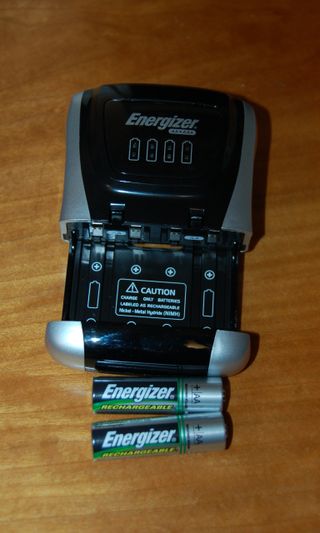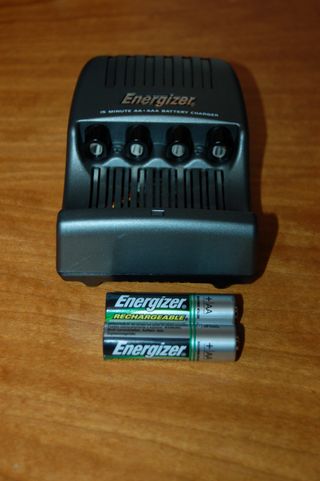Rechargeable Batteries Test
Makers of rechargeable batteries are vying to help stop you from tossing dead batteries. Which is brand and technology is the best?
Energizer Rechargeable
Price:
Household charger and 4 AA batteries – $30
Travel charger with 4 AA batteries – $25
4 AA batteries – $12
3 Stars
+ Choice of quick or small charger
Sign up to get the BEST of Tom's Guide direct to your inbox.
Get instant access to breaking news, the hottest reviews, great deals and helpful tips.
+ Desktop charger comes with AC and car adapters
+ Lifetime warranty on charger
- Short run times
- Quick charger has loud fan
- Batteries heat up during charging
Don’t ever throw the Energizer bunny away again. Instead, refresh and renew him with the company’s Rechargeable batteries. Unlike the other brands we tested, Energizer offers the choice of charging the cells with a small travel charger or quickly with a large device, but these batteries came up short on run times.
Based on nickel-metal hydride chemistry, the Energizer Rechargeable batteries come in a four-pack of AA cells with a large charger that promises 15 minute charges for $30 or a small travel charger with 4 AAs for $25. A package of four AAs costs $12.
The AA cells come pre-charged and are rated at 2,450 milli-amp hours (mah), a little short of the 2,500 mah that the PowerGenix NiZn batteries provide. After charging, they supply 1.46 volts, matching the Sanyo Eneloop cells but more than 0.3 volts short of the NiZn batteries.
I really like the 3.8-ounce travel charger, which is only slightly heavier than the Eneloop device, and can charge two or four AA or AAA cells. Don’t worry, you can’t put them in wrong—it won’t fit the wrong way.

It was able to charge two AAs in 2 hours 35 minutes, more than an hour longer than the NiZN’s charger but an hour quicker than the Eneloop’s charger. It uses a miniscule 3 watts of power, which translates into less than 5 cents of electricity a year for weekly recharges. LEDs blink furiously while charging, and the lights go solid when the batteries are ready.
If you’re in a hurry – and who isn’t these days – there’s also a quick charger that boasts 15 minutes to a fresh set of batteries. It isn’t actually as fast as it claims. We charged up a set of AA batteries in 22 minutes. But worse, it has a loud fan and used 48 watts of power during the charge cycle. It costs less than 10 cents a year to charge a set of batteries every week on this fast charger, but be careful--the batteries come out of the charger quite hot.

Energizer says that the Reghargeables can be recycled hundreds of times, which falls short of NiZN’s 1,000 cycle life. The Energizer bunny also let me down when it came to running my gear, with the shortest run times on both the flashlight (1 hour and 53 minutes) and the CD player (4 hours and 32 minutes). This is between one-half and one-third the longevity of a Duracell disposable battery, but still a good way to be green.
A bonus: the charger comes with a lifetime warranty for the original owner, meaning you’ll never have to buy another, which saves and the environment at the same time.
Current page: Energizer Rechargeable
Prev Page Rechargeable Batteries Test Next Page PowerGenix NiZn RechargeableBrian Nadel is a freelance writer and editor who specializes in technology reporting and reviewing. He works out of the suburban New York City area and has covered topics from nuclear power plants and Wi-Fi routers to cars and tablets. The former editor-in-chief of Mobile Computing and Communications, Nadel is the recipient of the TransPacific Writing Award.
-
It's worth noting that Kill-A-Watt type meters may not give reliable numbers at extremely low power consumptions.Reply
After some extensive testing that I looked at from my work I went with PowerEx batteries for myself. They've got a 2700 mAh capacity, and they held up at high current (> 10A). They weren't the cheapest ($19/4 pcs)
It's also worth noting that NiMH batteries all have the same chemistry, and can be charged by a standard NiMH charger. -
How does this article not point out the BIG difference between the regular nimh batteries and the new hybrid cells? The hybrid batteries, like the eneloop, will hold their charge when not in use. Regular nimh batteries will lost their charge quickly, even when not in use ( this is what allows them to ship the hybrid batteries pre-charged ).Reply
-
does anyone know if the chargers can be mixed-and-matched? I used a set of the rayovacs for a year with my digital camera, and they no longer work well. I am going to get eneloops now -- can I use my old rayovac charger?Reply
-
Shadow703793 benbagginsdoes anyone know if the chargers can be mixed-and-matched? I used a set of the rayovacs for a year with my digital camera, and they no longer work well. I am going to get eneloops now -- can I use my old rayovac charger?Generally, you can do it. I'v been using an Energizer recharger on my Sanyo's.Reply
Just a little tip: Keep an eye out on Amazon deals for Sanyo rechargeable. I got a 48 pack for under $20 during a sale (with out charger). -
I forget the total price for my Eneloop's but it was under $40 for four AA's, Four AAA's, a charger, and both a C and D converter at Costco.Reply
They last ten times longer in my Digital Camera Compared to Disposables.
They are the best. -
cadder There are a lot of differences from battery to battery.Reply
First the technology. Throw-away Alkalines have good capacity, reasonably good shelf life, and good voltage to start with but their voltage goes down a lot as they are used which is what causes flashlights to start going orange and dim after you use them a little while. NiMH and NiCad will usually maintain their voltage a little better until the end. LiIon is the best here but I don't think you can buy LiIon rechargeables in AA size. Also Alkalines don't work very well when cold, and their voltage will drop a lot under real heavy load. NiMh will maintain higher voltage and put out more current at the same time.
Different brands of NiMh have different capacity ratings, in milli-amp hour (mAH), and even at the same capacity they will vary in actual use just like these tests showed. NiCad is the worst for self-discharge, but NiMh is not too bad. They will work OK for devices that you use reasonably frequently but not for a flashlight that you put in the closet and use once a year. Alkalines will work better for this, but if you leave the device for several years then when you get ready to use it the batteries might have leaked and ruined the device. Use Lithium throwaways for this.
I haven't used the NiZn. I wonder what their voltage characteristics are under load.
NiCad and NiMh usually require different chargers but some chargers have a switch for this. I don't know if the NiMh and newer NiMh can use the same charger. Unfortunately the good battery chargers can be pretty expensive. Slow chargers tend to be the cheapest but a good fast charger can be a lot more convenient. -
kravmaga Something the review also omitted is that eneloops are known for exceptional performance retention after 500+ cycles of use whereas some other competing low self-discharge cells will degrade much faster.Reply
I have also heard of nutty people discharging them at more than 12C inside home-built portable aircraft landing lights with no damage where cheaper cells literally melted down. -
NewJohnny I'm the guy adding +1 to all the eneloop comments, for good reason. These are almost perfect batteries. True, the voltage is a little lower, but like mustang1068 pointed out, they retain a charge of 80% after 12 months of no use. I have them in all the game console controllers and kids toys.Reply -
starryman Hey great article minus the missing conclusion... I have both the Sanyo Eneloop and the Energizer rechargeable batteries with real world use for over a year. The Energizers are a pure waste of money. I bought 5 packs of 4 packs of the Energizers and have two of the chargers. After 3 months of use 6 of them stopped charging. Then 6 months later about half of them burned out. I noticed the Energizer batteries get realllllly hot when charging. The battery life on them drop significantly after 20-30 charges. The fast charging seems to kill them. The Eneloop batteries still work but the discharge rate sucks. I have a Canon 480EX camera flash and the Eneloops can't keep up. After 4 successive shots, it pauses for about 4 seconds. The Energizers can push out 9 successive shots before a pause but only good for maybe 60 shots and discharges to 20% if not used. Regular Alkaline batteries will give me 14 successive shots and give about 200 flash shots. Plus I can have them in the flash for months without worrying about them discharging to nothing. So at this point both the Eneloop and Energizers just sit in a tub and everyone once in awhile I have to pull out an Energizer that begins to corrode. At this point I've gone back to Alkaline batteries at Costco which is 48 AA for about $12. With Alkalines they have the perfect balance of longevity, discharge, and cost. I may try out the PowerGenix NiZn though... I just worry that it may toast my $400 camera flash.Reply
